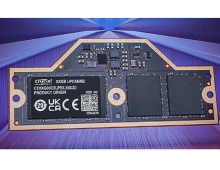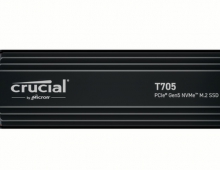
Micron Introduces a New Way to Increase Server Memory Capacity and Improve Performance
Micron Technology today announced that it has produced DDR3 load-reduced, dual-inline memory module (LRDIMM) and will begin sampling 16-gigabyte (GB) versions this fall.
By reducing load on the server memory bus, Microns LRDIMMs provide the option to support higher data frequencies and significantly increase memory capacity.
The new LRDIMMs will be manufactured using Microns 1.35-volt, 2-gigabit (Gb) 50-nanometer DDR3 memory chips. Microns 2Gb 50nm DDR3 product is currently in qualification with customers and is ramping toward high volume production.
Most midrange enterprise servers today utilize approximately 32GB of DRAM per system but this is expected to more than triple by 2012, according to a recent report from Gartner, Inc. (May 2009). With server manufacturers continuing to take advantage of multi-core processors and data centers opting for efficient virtualization technology, memory requirements are being driven ever higher. By increasing the available memory a server system has, it is able to run more programs concurrently, handle larger data files more efficiently, and generally exhibit better overall system performance.
Microns LRDIMMs currently use Inphis recently announced isolation memory buffer (iMB) chip in place of a register to reduce the bus load when transferring data between the memory and processor. Microns new LRDIMMs reduce this load by 50 percent for a dual-rank module and 75 percent for a quad-rank module, when compared to todays standard DDR3 server modules registered DIMMs (RDIMMs). By reducing the load on the bus, Microns LRDIMMs enable servers to handle higher frequencies of data to improve overall system performance and support increased number of modules for greater system memory capacity.
Today, using RDIMMs, a typical server system can accommodate up to three quad-rank 16GB RDIMMS per processor. However, that same system can support up to nine quad-rank 16GB LRDIMMS per processor, pushing the memory capacity from 48GB to 144GB. Measuring performance levels, Microns 16GB LRDIMM offers an increase of 57 percent in system memory bandwidth, when compared to an RDIMM. And as server power consumption continues to be a top concern for customers, Microns LRDIMMs will also operate at the industrys lowest 1.35-volts.
"With the rise in virtualization, our new 16GB modules allow customers to easily expand their memory capacity. While traditional RDIMMs limit the amount of memory that can be accommodated due to their loading profile, LRDIMMs eliminate that problem by reducing the module load," said Robert Feurle, vice president of DRAM marketing at Micron. "And because our LRDIMMs are designed using Microns new low-power 2Gb-based 50nm DDR3 chips, which reduces module chip count, we are providing customers with a more cost-effective and efficient means to scale server memory capacity and performance, while also reducing the power levels."
Micron is currently sampling an 8GB LRDIMM. Mass production of its 16GB LRDIMMs is expected to begin in 2010.
The new LRDIMMs will be manufactured using Microns 1.35-volt, 2-gigabit (Gb) 50-nanometer DDR3 memory chips. Microns 2Gb 50nm DDR3 product is currently in qualification with customers and is ramping toward high volume production.
Most midrange enterprise servers today utilize approximately 32GB of DRAM per system but this is expected to more than triple by 2012, according to a recent report from Gartner, Inc. (May 2009). With server manufacturers continuing to take advantage of multi-core processors and data centers opting for efficient virtualization technology, memory requirements are being driven ever higher. By increasing the available memory a server system has, it is able to run more programs concurrently, handle larger data files more efficiently, and generally exhibit better overall system performance.
Microns LRDIMMs currently use Inphis recently announced isolation memory buffer (iMB) chip in place of a register to reduce the bus load when transferring data between the memory and processor. Microns new LRDIMMs reduce this load by 50 percent for a dual-rank module and 75 percent for a quad-rank module, when compared to todays standard DDR3 server modules registered DIMMs (RDIMMs). By reducing the load on the bus, Microns LRDIMMs enable servers to handle higher frequencies of data to improve overall system performance and support increased number of modules for greater system memory capacity.
Today, using RDIMMs, a typical server system can accommodate up to three quad-rank 16GB RDIMMS per processor. However, that same system can support up to nine quad-rank 16GB LRDIMMS per processor, pushing the memory capacity from 48GB to 144GB. Measuring performance levels, Microns 16GB LRDIMM offers an increase of 57 percent in system memory bandwidth, when compared to an RDIMM. And as server power consumption continues to be a top concern for customers, Microns LRDIMMs will also operate at the industrys lowest 1.35-volts.
"With the rise in virtualization, our new 16GB modules allow customers to easily expand their memory capacity. While traditional RDIMMs limit the amount of memory that can be accommodated due to their loading profile, LRDIMMs eliminate that problem by reducing the module load," said Robert Feurle, vice president of DRAM marketing at Micron. "And because our LRDIMMs are designed using Microns new low-power 2Gb-based 50nm DDR3 chips, which reduces module chip count, we are providing customers with a more cost-effective and efficient means to scale server memory capacity and performance, while also reducing the power levels."
Micron is currently sampling an 8GB LRDIMM. Mass production of its 16GB LRDIMMs is expected to begin in 2010.





















